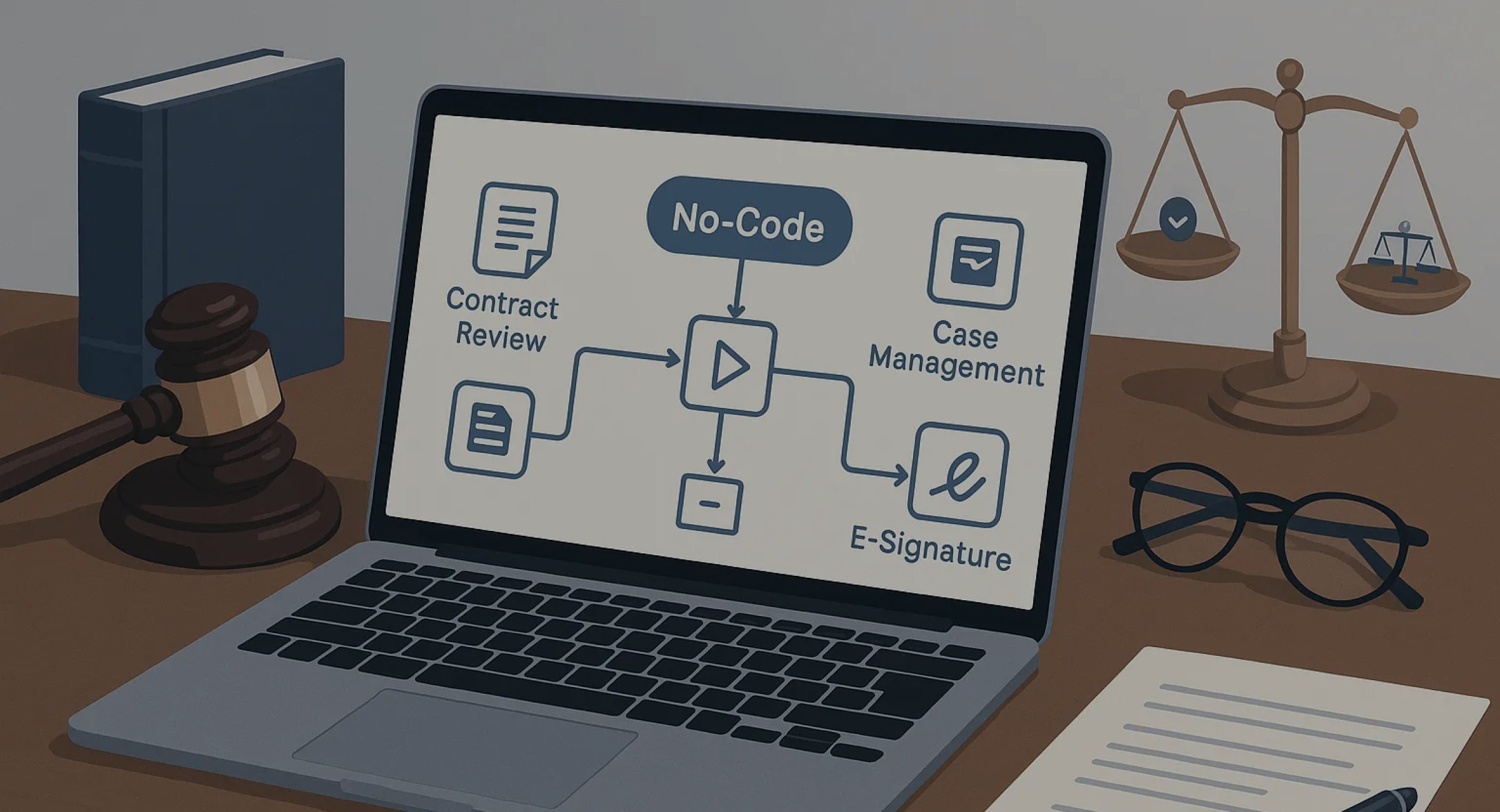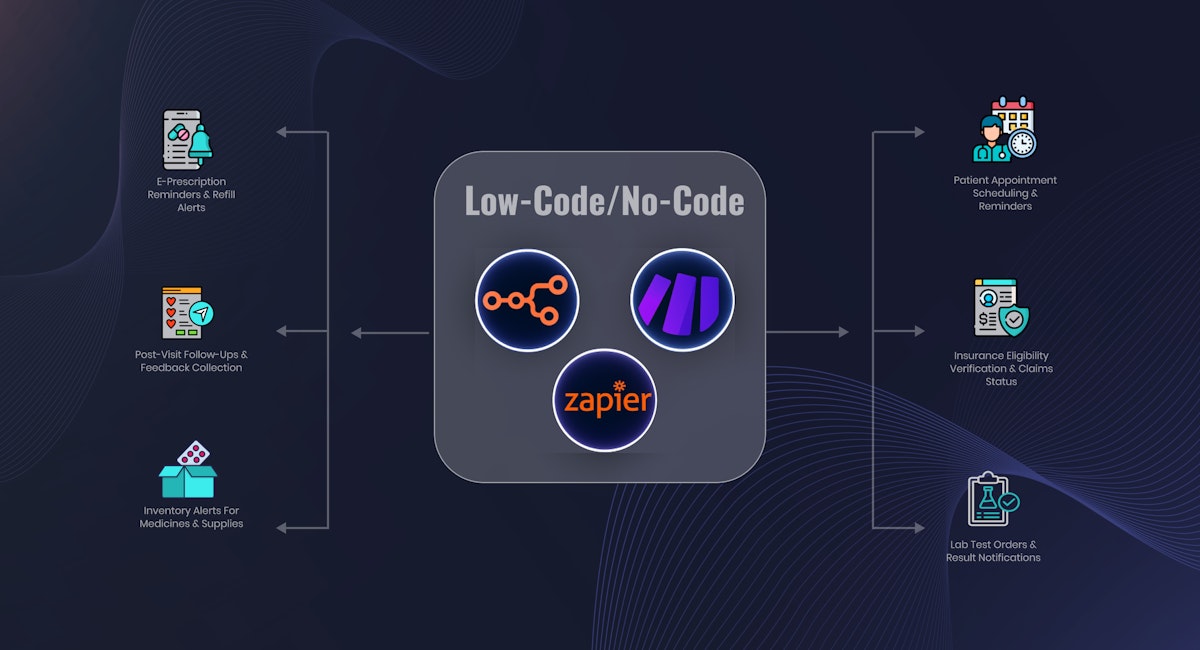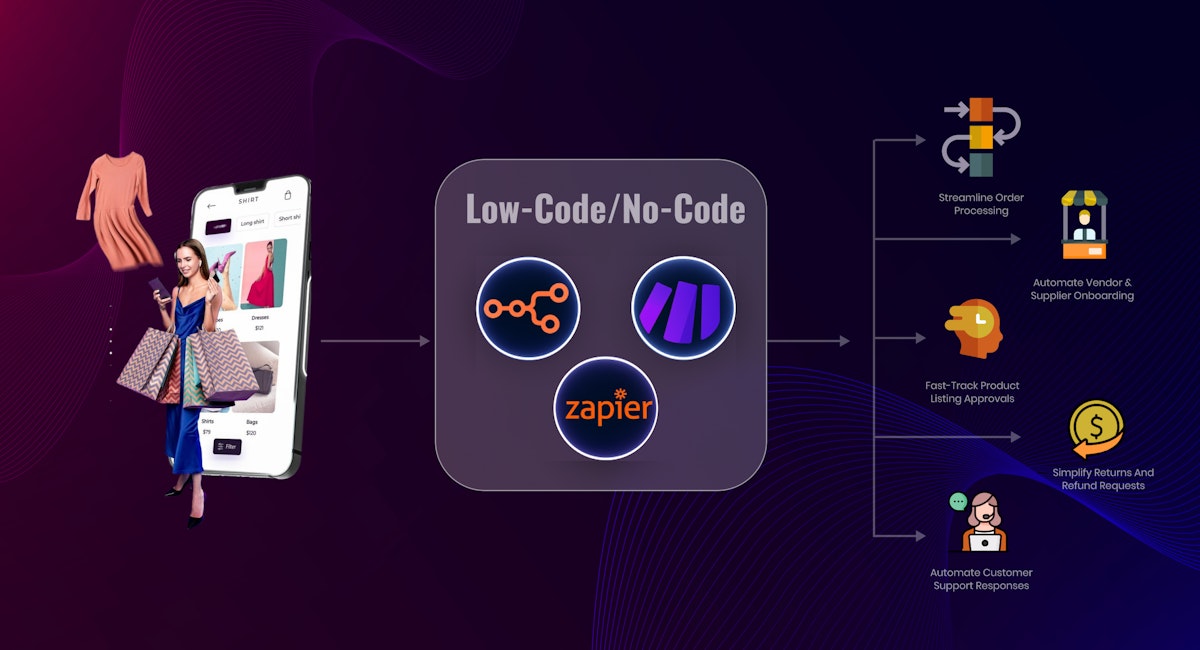Table of Content
Gone are the days when legal professionals would spend hours researching relevant cases, trawling through documents, and analyzing contracts.
With today’s clients expecting faster turnarounds and firms needing tighter control over operations without increasing overhead, legal work has become more process-driven with AI at the forefront.
You see, lawyers spend 69% of their time on non-billable admin, client comms, or business development. On the other hand, manual billing processes result in a potential loss of up to 26% in revenue. Even revenue collection is delayed by almost a whole week due to this.
Such gaps pose a strategic risk, making legal workflow automation a high priority for law firms. When tasks such as client intake, contract drafting, and compliance tracking are systematized, the value of the legal services ultimately increases.
In addition, low-code/no-code (LCNC) tools make this even more accessible. They help build and run automations, minus the complexity or cost of traditional IT projects.
So, if you’re keen to understand specific ways legal process automation can improve efficiency across your law firm, keep reading this guide. You’ll learn to apply low-code solutions in areas that drain time and introduce risk, and how an AI-first partner like Intuz can help you get there.

Legal Automation: 5 Tasks to Automate with Low-Code/No-Code Tools
1. Streamline client intake and onboarding to save hours weekly
Did you know 42% of law firms take more than three days to respond to a new potential client inquiry? And when they do, intake happens across disconnected tools, such as emails and spreadsheets, making it easy for key information to fall through the cracks.
When preliminary data isn’t collected properly, conducting evaluations and potentially onboarding the clients becomes daunting. Fix that with legal workflow automation.
With LCNC tools:
- Use web-based forms to collect structured client data and trigger emails automatically if a form is incomplete or if documents aren’t submitted on time.
- Let clients book time directly via integrated scheduling tools, such as Calendly or Microsoft Bookings, so your team doesn’t have to.
- Sync all client data with any practice management system (e.g., Clio, PracticePanther, MyCase) to maintain a clean, centralized record.
Result:
By automating your intake workflow, you reduce administrative time by 25–45%, improve data accuracy, and ensure every new client experience starts with structure and clarity.
Intuz’s Expert Tip:
We recommend using field-level validation and conditional logic in your intake forms so clients only see questions relevant to them. This improves form completion rates and ensures that you capture quality data from the start.

2. Close deals faster with automated contract drafting and e-signature workflows
Contract creation is essential to your legal practice, but it demands thoroughness.
From manually drafting agreements to chasing internal approvals and coordinating signatures, a significant amount of effort is invested in this process, which often slows momentum and delays outcomes.
AI-powered legal workflow automation with LCNC tools helps you:
- Build a dynamic form that guides clients through key contract options. Based on the input, the system automatically inserts the correct clauses.
- Use pre-approved templates to generate NDAs, engagement letters, and service agreements instantly without starting from scratch.
- Connect with tools like DocuSign or HelloSign to send documents for signature as soon as they’re ready.
- Set automatic alerts to team members when approvals are needed or when a contract is fully executed.
Result:
AI‑powered contract lifecycle management (CLM) can achieve an 80% reduction in contract processing time. Additionally, your clients receive timely service, and your team spends less time managing document versions and chasing approvals.
Intuz’s Expert Tip:
To reduce risk exposure, we suggest implementing version-controlled contract libraries with padlocked sections. That ensures your team only edits what’s meant to be customized, keeping the core legal language intact and fully compliant.

3. Automate billing, approvals, and reminders to get paid on time
Billing is tedious for any organization. Manual invoice creation, delayed approvals, and inconsistent follow-ups are particularly common in law firms, which can extend payment cycles and negatively impact the bottom line.
And if you’re managing multiple clients and matters, the billing admin will compound quickly. Legal workflow automation software comes to the rescue, enabling you to:
- Set triggers based on task or milestone completion to generate draft invoices using time and expense data from your practice management system.
- Automatically send invoices to the right reviewer before they’re finalized, with reminders if no action is taken.
- Schedule polite, branded reminders for upcoming or overdue payments, customized by client type or payment terms.
- Sync with platforms like Xero, QuickBooks, or Sage Intacct for real-time financial visibility.
Result:
As shown below, firms that adopt email invoicing, bulk billing, and balance summaries experience significantly higher realization rates.
| Billing Automation Method | Realization Rate Increase | Collection Rate Increase |
|---|---|---|
| Email Invoicing | +25% | — |
| Outstanding Balance Summaries | +26% | +5% |
| Bulk Billing | +21% | — |
Source: Clio 2023 Legal Trends Report
Investing in AI-powered legal workflow automation can also save you up to $19,000 per legal professional and demonstrate a $32 billion annual impact across legal and tax/accounting functions due to time savings.
Intuz’s Expert Tip:
In billing automation setups, we always recommend building in escalation logic. If a reviewer doesn’t take action within a set window, the invoice auto-escalates to a backup approver to keep your payment cycle moving.
4. Monitor and report on compliance proactively
Regulatory compliance is non-negotiable. However, manually tracking document requirements, critical deadlines, and audit readiness puts unnecessary pressure on your team. Compliance processes aren’t supposed to rely on inboxes and Excel.
They’re supposed to be carried out with complete visibility and control. Legal workflow automation powered by LCNC tools helps you:
- Set recurring reminders for key deadlines, license renewals, and filing dates across jurisdictions.
- Track whether required documents are uploaded, signed, or pending, with automatic notifications for missing items.
- Capture and log who did what, when, and why, creating a verifiable compliance record without manual logging.
- Auto-generate compliance reports for internal reviews or external audits, reducing prep time and stress.
Result:
Compliance burden reduces by 30%—a plus, as many jurisdictions now expect law firms to demonstrate systems-based compliance processes.
Intuz’s Expert Tip:
Rather than relying on calendar reminders, design recurring compliance workflows with time-based triggers. For example, automate license renewal alerts 90 days in advance to prevent missed deadlines.
5. Automate matter creation, task assignment, and deadline tracking with ease
When new legal matters are created manually, critical steps like conflict checks, deadline tracking, and team assignments are often delayed or overlooked. This means teams may start work before documents are in place, roles are unclear, or deadlines slip through the cracks.
Legal workflow automation provides a structured and repeatable approach to launching and managing matters through to completion. With LCNC tools, you can:
- Ensure that a new matter record is created automatically as soon as a client signs an engagement letter or completes the intake process.
- Assign roles, checklist items, and responsibilities based on matter type, practice area, or client category.
- Auto-generate key dates and sync with Outlook or Google Calendar.
- Link workflows with project management tools like Trello, Asana, or Monday.com to track execution in real time.
Result:
By automating workflows, firms were able to reduce admin time (34.8% now spend under an hour weekly assigning work), speed up document collection (45.5%), and improve collaboration (32.9%).
Intuz’s Expert Tip:
We calculate deadlines dynamically, such as ‘hearing date + 30 days,’ rather than hardcoding dates. Therefore, if a timeline shifts, your workflows adapt without needing manual edits.
Let's Automate Your Legal Workflow!
Contact UsHow Intuz Can Help You Implement Legal Workflow Automation
We at Intuz strongly believe automation doesn’t need to be complex or disruptive. You don’t need to overhaul your existing systems or retrain your staff. You just need to focus on solving real operational problems with practical, scalable tools. Here’s how we can help you:

1. Identify repetitive legal processes
We’ll start by mapping your current workflows and spotting where time or revenue is lost. If your team is wasting resources chasing client documents, we’ll focus on developing a process that enables you to retrieve data via secure forms and automated reminders.
2. Set clear goals
Every automation project needs a business case. Before building anything, we align our automation efforts with your firm’s operational priorities. For instance, if you want to speed up contract turnaround, we’ll set a target, such as reducing the average draft time from 3 days to 1.
3. Choose the right low-code/no-code platform
This one’s an important step. Based on your needs and existing tools, we recommend the best-fit LCNC platform, one that integrates seamlessly with your systems without requiring custom development.
For example, if you want to automate case creation but your team already uses Microsoft 365, we might recommend building your workflows using Power Automate and SharePoint, rather than introducing a new platform.
4. Build and test simple workflows first
This is the phase where we prototype workflows with one or two high-impact areas. Once results are visible, we iterate and then expand from there.
If you want to automate all engagement documents eventually, we’ll start with a single NDA workflow. Once that’s working smoothly, we’ll add other templates, such as service agreements and engagement letters.
5. Integrate with your existing legal tools
Whether you’re using Clio, NetDocuments, MyCase, or Microsoft 365, we make sure the new workflows connect easily. You keep your core systems while gaining new efficiencies on top of them, not separately.
A 2024 Thomson Reuters report suggests AI will have a high or transformational impact on the legal profession by the next five years. Moreover, 53% of firms are already seeing ROI directly or indirectly after adopting some form of AI for their workflows.
More recently, a 15-lawyer commercial litigation firm automated its intake and billing processes with Intuz. Within six weeks, they recovered over 12 hours of administrative time per lawyer per month and improved invoice turnaround by 40%.
The results speak for themselves.
AI-powered legal workflow automation has the potential to transform the way your law firm operates. And we’re here to help.
Book a free consultation with Intuz to explore what’s possible—you won’t be disappointed.







